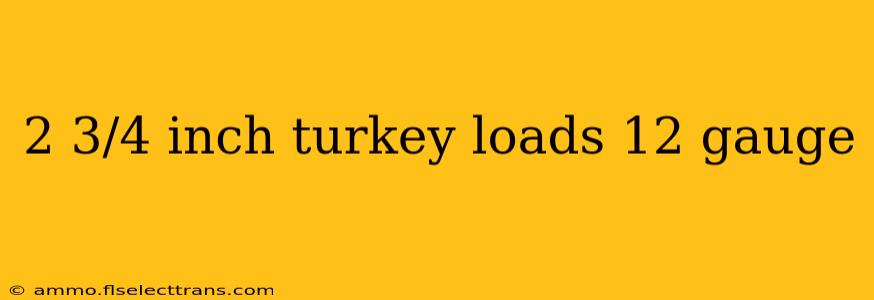Turkey hunting presents unique challenges, demanding specialized ammunition for effective harvests. Among the most popular choices are 2 3/4-inch 12-gauge turkey loads, offering a potent blend of power and versatility. This guide delves into the nuances of these loads, helping you choose the best option for your hunting needs.
Understanding 2 3/4 Inch Turkey Loads
Before diving into specifics, it's crucial to understand the components of a 2 3/4-inch 12-gauge turkey load. These shells utilize a shorter casing than their 3-inch counterparts, resulting in slightly less overall payload but still packing a substantial punch. The key elements include:
-
Shot Size: Turkey loads typically employ larger shot sizes like #4, #5, and #6. Larger shot sizes deliver greater energy at longer ranges, vital for ethical and successful harvests. The choice depends on the hunting situation – closer shots may allow for smaller shot sizes, while longer ranges benefit from larger ones.
-
Shot Type: This refers to the material of the shot itself, commonly lead, but increasingly, non-toxic alternatives like tungsten-matrix, bismuth, or steel. Non-toxic shot is crucial where regulations mandate its use. Each type possesses unique ballistic characteristics influencing range and penetration.
-
Choke Tube: The appropriate choke tube significantly impacts shot pattern density. For turkey hunting, full or extra-full chokes are generally preferred to concentrate the shot pattern for a clean kill. Using the wrong choke can result in a scattered pattern, reducing effectiveness.
-
Powder Charge: The amount of gunpowder in the shell influences the velocity of the shot. Higher velocity translates to flatter trajectory and greater range, although this can also increase recoil.
Choosing the Right 2 3/4 Inch Load for Your Needs
Selecting the optimal 2 3/4-inch 12-gauge turkey load involves considering several factors:
1. Hunting Distance:
-
Closer Shots (under 30 yards): Smaller shot sizes like #5 or #6 may suffice, delivering sufficient energy while minimizing the risk of excessive damage.
-
Medium Ranges (30-40 yards): #4 shot generally performs well, maintaining sufficient energy for clean kills.
-
Longer Ranges (40+ yards): Larger shot sizes and higher velocity loads are recommended, but accuracy becomes increasingly crucial at these distances. Consider the ethical implications of shooting at such ranges.
2. Shot Type Considerations:
-
Lead Shot: Offers excellent performance at a lower cost but is restricted or prohibited in many hunting areas due to environmental concerns.
-
Non-Toxic Shot: Environmentally friendly options like tungsten-matrix, bismuth, and steel offer comparable performance to lead, but at a higher price point.
3. Recoil Management:
While 2 3/4-inch loads generally produce less recoil than 3-inch loads, choosing lighter loads or using a recoil pad can enhance shooting comfort, especially for extended hunting sessions.
Optimizing Your Shooting Technique
Even with the best ammunition, proper shooting technique is paramount for success. This includes:
-
Proper Gun Fit: Ensure your shotgun fits comfortably and allows for proper alignment and swing.
-
Practice: Regular practice with your chosen load and choke is essential to develop consistent accuracy and shot placement.
-
Patience: Turkey hunting requires patience and careful observation. Resist hasty shots, and only take shots you're confident you can make.
Conclusion
2 3/4-inch 12-gauge turkey loads offer a practical and effective option for many turkey hunters. By carefully considering shot size, shot type, choke tube, and hunting distance, you can select the ideal load to maximize your chances of a successful and ethical harvest. Remember to always prioritize safety and practice responsible hunting techniques. Happy hunting!

